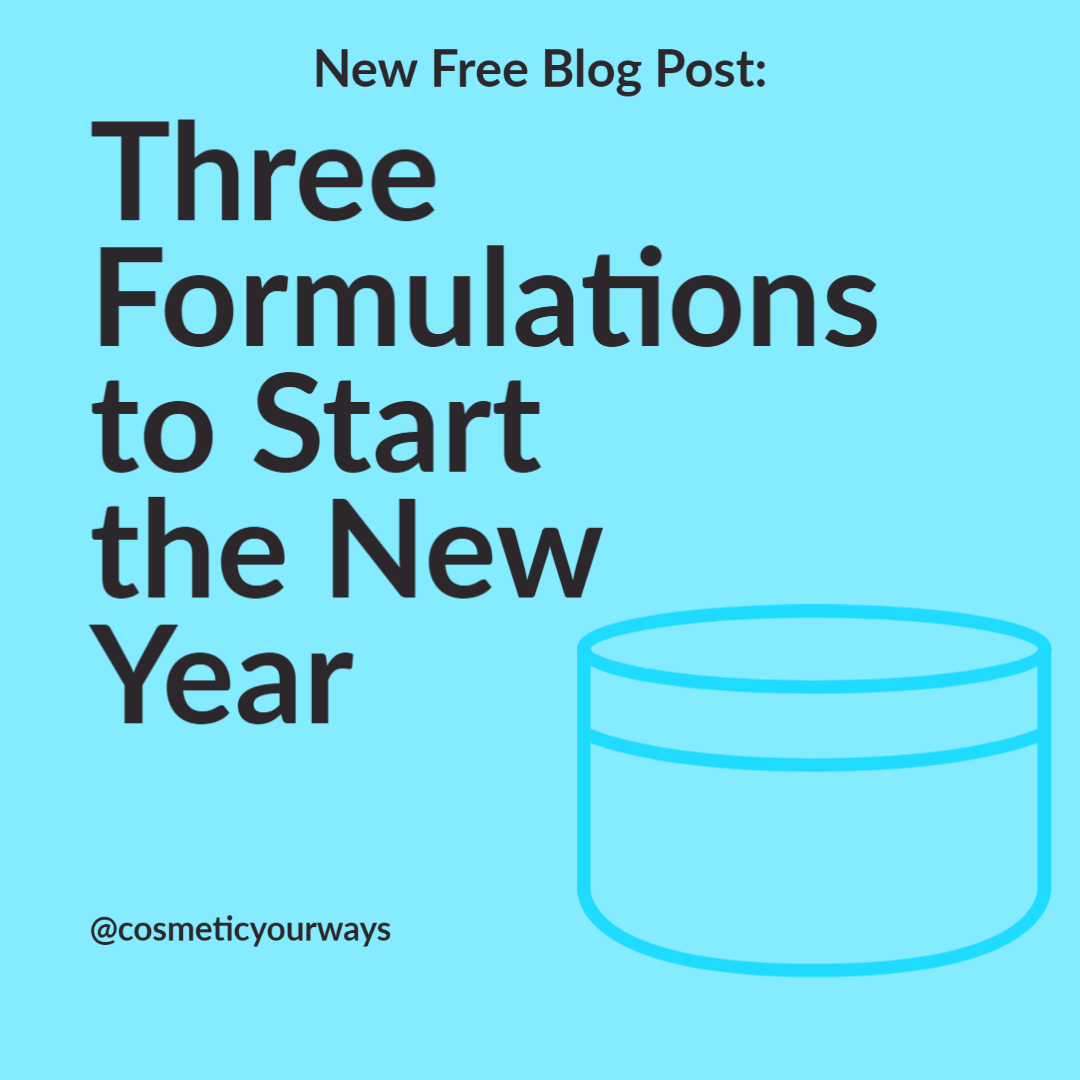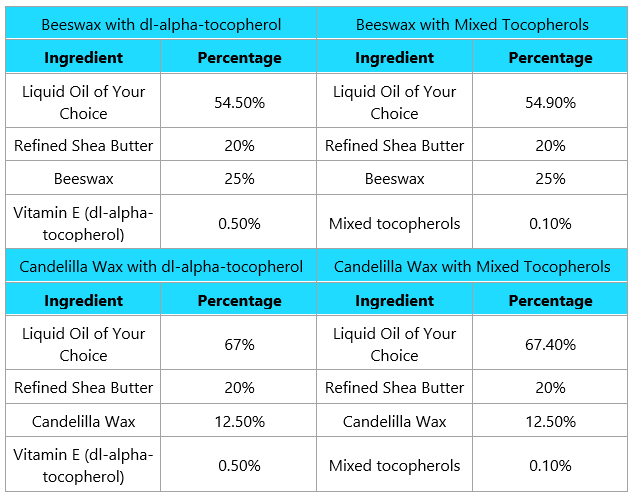|
Formulating your own cosmetics is so rewarding. So for this free post, I want to share three easy formulations that you can make for the new year. I will focus on easy ingredients that you can find readily on Amazon. These will be great first-time projects. This post will assume that you know how to scale formulations. If you do not then please read this post. (Link) The equipment that you will need is a scale, glass beaker, something to stir with like a lab spoon, and something to whisk. Make sure whatever that you use, it is only for formulating and not for food. For the ingredients, I want a liquid oil, refined shea butter, beeswax, and vitamin E. Let's talk about these. Vegetable Oil: This is going to be our ingredient that makes all the other products spread. Jojoba oil is a great one for just starting out. As a side note, jojoba oil is not an oil, it is a liquid wax. Other options would be Caprylic/Capric Triglycerides (fractionated coconut oil), Avocado Oil, Apricot Kernel Oil, Sweet Almond Oil, Sunflower Oil, Safflower Oil. You can choose one or two of these and that would be a great start. Caprylic/Capric Triglycerides (fractionated coconut oil): non-greasy, lightweight for a vegetable oil, clear and odorless Jojoba Oil: Liquid Wax, Great for all skin types, non-greasy. Avocado Oil: Great for lip products, has great cushion, heaviest out of all the oils. Great for dry skin. Apricot Kernel Oil: Heaver than sunflower oil but not as heavy as avocado oil. Great for Sweet Almond Oil: Avoid if you have a nut allergy. Great for dry skin Sunflower Oil: not as light as Caprylic/Capric Triglycerides or Jojoba oil but not as heavy as Apricot kernel oil or sweet almond oil. Great for all skin types. Safflower Oil: Very similar to sunflower oil. Refined Shea Butter: I specifically recommend refined shea butter. The scent of shea butter is polarizing for many, you either love it or hate it. It has a characteristic smokey smell. If the quality is not good it can smell funky. The refined version has little to no scent. The refined version can also be better if you tend to get gains in your formulations. The method I have made for these formulations should prevent that all together, but I wanted to mention it. If you do not like greasy products, you can swap out the refined shea butter with refined mango butter as well. It has a dry touch finish that is amazing. Beeswax: While this ingredient is not vegan, it is one of the easiest to work with. I love the texture that it gives to products. If you really want to use another one; I would use candelilla wax. I will include how to alter the formulas when we get there. Basically, you want to use half the amount of candelilla wax as you would use beeswax. So if we wanted to use 25% beeswax. We would do this: 25/2=12.5 So we would use 12.5% Candelilla wax. Vitamin E: This is important for extending the life of our oils and butters. A common misconception is that it is a preservative. This is not true. I think where the confusion comes from is both vitamin e and vitamin E extend the shelf life of our products. But they do this in very different ways. Notes for purchasing: Purchasing vitamin E can be very confusing. There are many versions of vitamin E. Some are great for our oils and others are more for our skin. You do not want to buy the ones that are in the pharmacy, They usually list the IU. They are a blend of usually soybean oil and tocopherols. This is not the one that you want to use. The other one is a clear viscous liquid. This one is tocopherol acetate, this one is for the skin and will not help with slowing oxidation of your oils. This may be one of the ingredients that you may want to purchase from a supplier. You either want Mixed tocopherols or dl-alpha-tocopherol. These are meant to slow the rancidity of your oils and butters. Mixed tocopherols have the International Cosmetics Ingredient name (INCI) of tocopherol. It is a blend of different tocopherols. dl-alpha-tocopherol is the INCI name of this material, some suppliers call this just vitamin E. Making Cosmetics sells dl-alpha-tocopherol, I have been using this since the beginning. Mixed tocopherols are sold by lotion crafter and new directions aromatics. I am not being paid to say that I am just sharing where I have purchased these ingredients before. Note: dl-alpha-tocopherol and Mixed tocopherols are used at different percentages. In the formulations, I will share the percentages I recommend depending on the vitamin E that you are using. As long as you have one of those you will be okay. It is a staple ingredient to have. If you really cannot find it you can leave it out. Just be mindful that your expiration date is of the ingredients that go bad the soonest. For all of these please buy in small quantities if you can. I can be very tempting to buy massive tubs but I have found that all many ingredients go bad before I can use it all. So you may think that you have saved money but if you do not use all of it did you really save any money? Simple Lip Balm (with dl-alpha-tocopherol): Calculations:
Calculations:
Really any of the oils are good for lip balms. I have recently been obsessed with avocado oil in Lipbalm. If you want to use candelilla wax then see the chart below. Different Alterations of the Lipbalm: For all of these formulations, the method is the same. the only difference is that if you change the wax, the melting point will be different. Candelilla wax takes longer to melt. I hope this helps you understand how to alter these formulations. For the rest of the formulations I am just going to write dl-alpha-tocopherol. Simple Body Butter: Calculation:
Depending on where you live and the time of year, you may need to adjust the formulation to be harder to softer. If you live in a warmer climate, then you will want to increase the percentage of refined shea butter. Take the additional percentage from the liquid oil. Try 75%-80% shea butter. If where you live is colder, then you can decrease the percentage of refined shea butter that you use and replace the percentage with liquid Oil. I would try this formula out first. This was made to be a bit softer of a formulation. A reminder that all formulations should add to 100%. To make a lighter product, you can swap the shea butter with mango butter. For the liquid oil, I would choose, either Caprylic/Capric Triglycerides or jojoba oil. Simple Nail and Cuticle Oil: Calculations:
100-(5+5+0.5)=89.5 89.50/4=22.375 (22.37) 5/4=1.25 0.5/4=0.125 (0.13) Method:
I hope you learned something new from this post. As always, if you have any questions, comments, or concerns, do let me know in the comments below. Thank you. Cheers to the New Years!  This work is licensed under a Creative Commons Attribution-NonCommercial-ShareAlike 4.0 International License.
1 Comment
Zachariah Kovac
1/2/2022 07:19:59 am
Let me know what you think of the post!
Reply
Leave a Reply. |
Disclaimer!You are at your own risk when making anything from this blog. I am not liable for any mishaps that may occur. I do my best to include everything in the procedure so, that accident are less likely occur! Archives
June 2024
Categories
All
|







 RSS Feed
RSS Feed